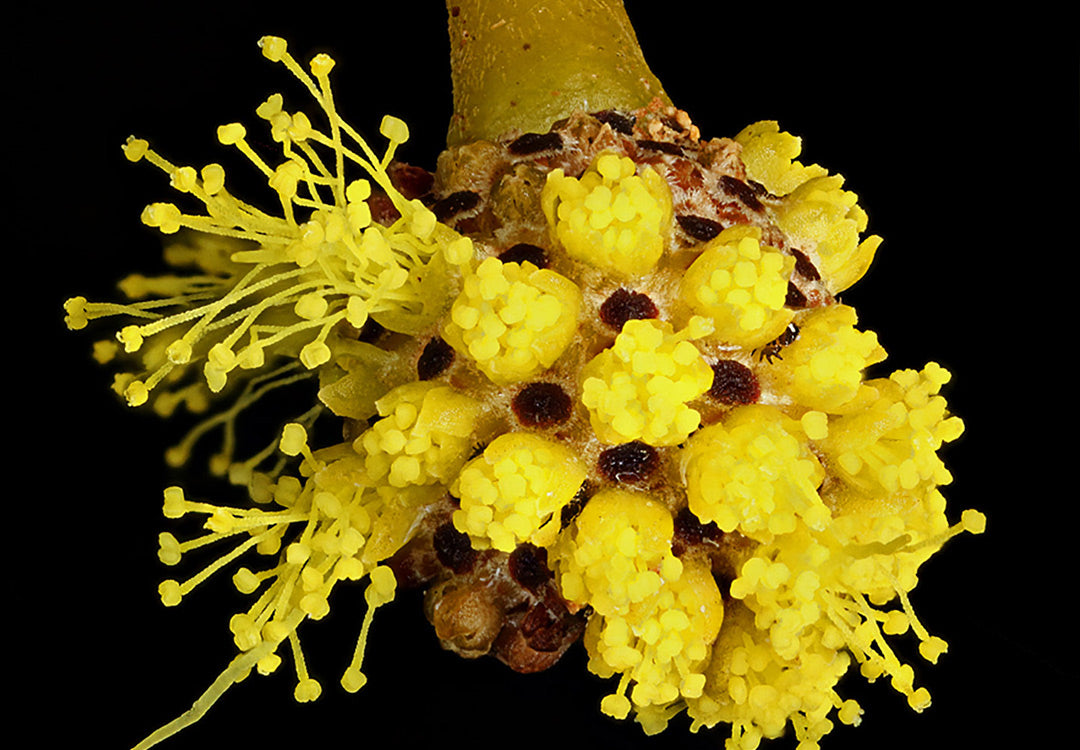
The Mimosoideae subfamily is a clade that includes many native Australian plants as well as some that have originated from overseas. The most noteworthy genus is probably Acacia, or the wattle group of plants.
Believe it or not, this subfamily is actually a clade beneath the greater legume family Fabaceae, though on the surface they don’t seem to have much in common with other pea family members other than bean pods and the ability to synthesise or “fix” nitrogen from the air using symbiotic rhizobial bacteria.
Description
The flowers certainly don’t look like any pea flower we’d recognise. They are quite small and usually form an inflorescence or compound flower that looks like a fluffy pom-pom.
Unlike other legumes and peas, acacias and their close relatives have flowers that are radially symmetrical, or regular.

Flowers opening on a golden wattle inflorescence, Acacia pycnantha. Image source

Wattle flowers, leaves and seed pod, Acacia confusa. Image source
Most acacias, also called wattles grow as small to large shrubs, with a few larger tree varieties thrown in as well. Other Mimosoideae members can provide ground cover, such as the so-called “sensitive plants”.
Flowers, Fruits & Leaves
Sepals: 4 to 5 small sepals.
Petals: 4 to 5 small petals.
Male: many stamina creating a fluffy effect similar to a eucalyptus flower.
Female: a single pistil typically rising out of the centre of the surrounding stamina.
Fruit: bean pods, sometimes long, stubby or roundish.
Seeds: beans.
Leaves: can be bipinnately compound. Sometimes with seemingly simple leaves with parallel leaf venation though they are dicots. These seemingly simple leaves are in fact not leaves at all but are modified petioles with the appearance of leaves called phyllodes that are able to photosynthesise.
Edible Or Poisonous
Some wattle beans are edible and many people do enjoy them, however they aren’t a significant crop.
There are, however a few poisonous variations out there, so excercise caution when foraging and always bring someone who’s experienced in identifying foods and poison.
Aboriginal Australians are said to have eaten various parts of certain acacias including roots, sap and even insect galls growing in the flesh of the plant.
Noteworthy Types
Wattles in the Acacia genus are the main players in this group, with their fluoro yellow pom-pom inflorescences. Possibly the best-known variety might be the golden wattle, Acacia pycnantha.

Golden wattle, Acacia pycnantha, inflorescence up close. Image source
There are some invasive weed species, such as prickly acacia Acacia nilotica which is a nationally significant threat that unbalances the ecosystem, provides unfavourable conditions for grasses. It has a negative impact on the economy by reducing agricultural and pastoral productivity. It’s also prickly and dangerous.

The prickly acacia, Acacia nilotica. Image source
Another noteworthy genus in the family is Mimosa, consisting of ground covering herbs and shrubs most notably sensitive plants.

Sensitive plant, Mimosa pudica. Image source
Albizia julibrissin is colloquially known as the Persian or Chinese silk tree, or the mimosa tree, and is a plant that looks like a cross between a wattle and a sensitive plant.

Branches of the silk tree Albizia julibrissin with bean pods, flowers and bipinnate leaves showing. Image source
Conclusion
It’s easy to mistake these guys as being related to bottle brushes and eucalypts in the Myrtyceae family, if it weren’t for the bean pods and the nitrogen fixation pointing towards them being in the legume family.
Part of me doesn’t want to accept that these guys are so closely related to peas with their iconic flower, but we just have to move on with life and accept it.
If you haven’t already read my articles on plant identification and scientific names, I recommend reading those to get a broader picture of the topic. Alternatively, you can browse some of my other plant families, subfamilies and genera below.
